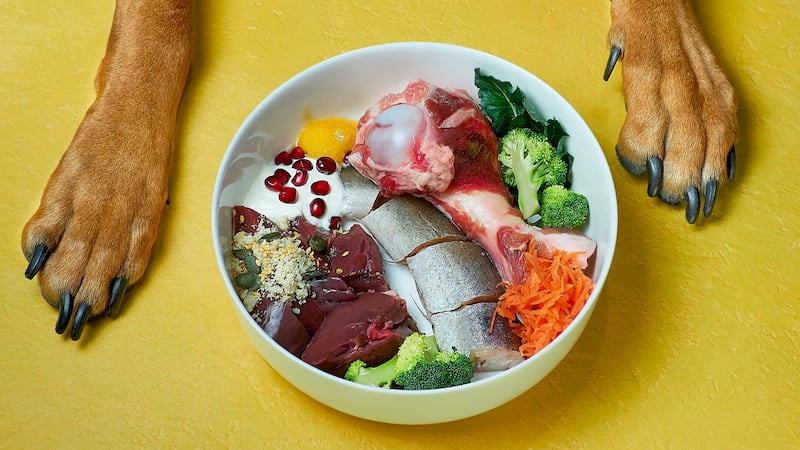"We trust people to leave the hospital with a baby and keep it alive," Debora Robertson, journalist and author of Dogs' Dinners and Cooking for Cats, sighs down the phone. "We trust them to feed their children, but not their pets. Isn't that mad?"
Dog behaviourist Louise Glazebrook agrees: "The constant explanation that we could not possibly be relied upon to feed a dog without one of three multinational corporations putting it in a bag and flogging it to us at a ridiculous price really does make my blood boil."
Put like that, it does seem strange. Yet, like many pet owners who cook for other humans without a second thought, I’m oddly nervous of admitting I sometimes also prepare food for my terrier. Robertson recalls when she first wrote about it: “I felt like I was coming out of a very strange closet … but it was clearly a big one, because so many people got in touch to say they did it too. It all went a bit nuts to be honest.”
And this was before our pets were stuck with us at home all day: spikes in Google searches for “home-made dog treats” in the past year suggest that when we aren’t baking banana bread for ourselves, we’ve been cooking up a storm for our furry friends.
Alison Daniel, co-founder of My Pet Nutritionist.com, has had to hire three new members of staff to keep up with demand. "The major thing is people who are at home more noticing that perhaps their dog's health isn't so great – and also, pets taking on the stress of their owners. Pet behaviour and anxiety issues are through the roof."
Chef Asma Khan confesses she makes turkey keema and roast chicken for her kitten, while one Instagram friend says she swore her two west highland terriers would never eat anything but dog food – "but that has changed since lockdown started". Whether it's for health or environmental reasons, or simply as a way to show love, increasing numbers of us are turning away from mass-produced pet food.

My vet confirms this, but is less than enthusiastic about the trend, remembering the many cases of malnutrition he saw before commercial diets became the norm – taurine deficiency in cats in particular. But Daniella Dos Santos, senior vice president of the British Veterinary Association, says it’s great that more people are “taking an interest” in their pet’s diet – “as long as it’s done responsibly and safely”. She explains that members of the Pet Food Manufacturers Association must adhere to strict nutritional guidelines set by the European Pet Food Industry – whose website informs me that a dog needs “around 37 basic nutrients in his daily diet, and a cat over 40”.
“Basically,” Dos Santos says, “it’s much easier to get it wrong than it is to get it right.” Dos Santos does have concerns about those contemplating vegetarian and vegan diets for their animals, however. Cats, as obligate carnivores, derive all their nutrition from meat and should not be deprived of it. While “it’s theoretically possible” for dogs to get everything they need from a vegetarian or vegan diet, “you must speak to a professional first”, whether that’s your own vet or a veterinary nutritionist.
Robertson, who took advice from a vet as well as several nutritionists for her cookbooks, stresses that it’s important to take a “cautious and intelligent approach” to the food you choose, and remember that just because you like something it doesn’t mean your pet will. (“That feeling that you want to spoil your cat by baking them a cake,” she says, “you’re doing that for you, not them.”)
Daniel points out that each animal is an individual – “different breeds, different sizes, different ages, activity levels … what’s going to work for one isn’t going to work for another. They’re like us, they have their likes and dislikes.” Her clients fill in a comprehensive questionnaire on their pet’s health before the initial consultation to enable her to develop a bespoke feeding plan that suits them, “whether that’s commercial fresh food, or recipes to prepare themselves”.
Glazebrook, too, admits cooking for your dog isn’t for everyone, even in a pandemic, but stresses owners shouldn’t feel bamboozled into buying any old stuff either. “The impact of an inadequate diet is huge,” she tells me.
“I’m currently seeing a lot of puppies that are desperately hungry, almost starving, because although they are eating a lot, the quality is not good enough. It isn’t meeting their needs, which is impacting their behaviour – stealing things from counters, scavenging, running off with food, all because the particular brand of food that is being fed is not right for them.”
First-time puppy owners can be forgiven for playing it safe: the prospect of keeping a baby of any species alive is a daunting one. I remember anxiously asking the breeder of my dog, Wilf, how we’d know when he was hungry (laugh? She almost died!), and sending my boyfriend out to diligently comb the shelves for the UHT goat’s milk she’d recommended.
For the first few months of his life, he enjoyed a carefully weighed out, age-specific diet. The only human food he knew was the English mustard we were forced to coat the table legs with to try and stop him chewing them. And then, one fateful day, he who will not be named decided to give him a bit of bacon from his breakfast plate. Things were not the same after that.

Gradually, as I became less nervous about killing this apparently robust little animal, I began adding the odd scrap or tin of fish to his dry food, scrambling him an egg or poaching him some chicken and rice when he was a bit off colour – the way dogs I knew growing up had been fed. These days he generally eats about half home-made offerings, half kibble. But for the purposes of this piece, Wilf has been treated to two whole weeks of home-cooked meals.
Some were more popular than others – he refused to even sniff a banana smoothie, and hesitated for two whole seconds before devouring a buckwheat pancake with raw spinach and cottage cheese. However, Robertson’s chicken and vegetable soup proved an excellent place to hide some medication he was briefly prescribed, and her tinned salmon fishcakes have him licking the bowl long after a lesser animal would have accepted defeat.
I bake him liver-chip cookies from Lily’s Kitchen founder Henrietta Morrison’s book of Tasty Treats for Happy Dogs – then have to hide them from both him and myself (they look disconcertingly like the chocolate variety) – and lamb meatloaf and burgers from Sean McCormack’s The Happy Dog Cookbook. I order organic kelp powder and bonemeal online to sneak into chopped meat and vegetables for one of the recipes available on Daniel’s website, and, on Valentine’s Day, I spend four hours braising him a beef cheek with root vegetables, which I fondly hope will buy his love for the next 364 days.
Wilf wolfs them all with appreciably more snorty gusto than he usually greets a bowl of dry biscuits. That said, when I present him with a dish of homemade shepherd’s pie and peas next to a small helping of bog-standard big-brand dog food, he sniffs the sweet potato mash and then picks the other bowl.
Pearls before swine, perhaps – I’m under no illusions that most of all he’d like a fried chicken bone scavenged from the gutter – but for me, it’s a useful way to ensure the meat in his diet is as ethically sourced as I’d want in my own (fortunately we both have a taste for cheap cuts).
If you can batch cook it’s not too much work, and as a bonus, without the fillers that bulk out some commercial dog food, there’s less to deal with at the other end.
But then I have the considerable luxuries of time, money and freezer space, plus a pet who, smoothies aside, will eat almost anything; not every pet does. But if you do, remember that you also have the luxury of choice. As Glazebrook says, there are many ways to feed a pet: “It doesn’t have to come from a plastic bag.” – Guardian.

















